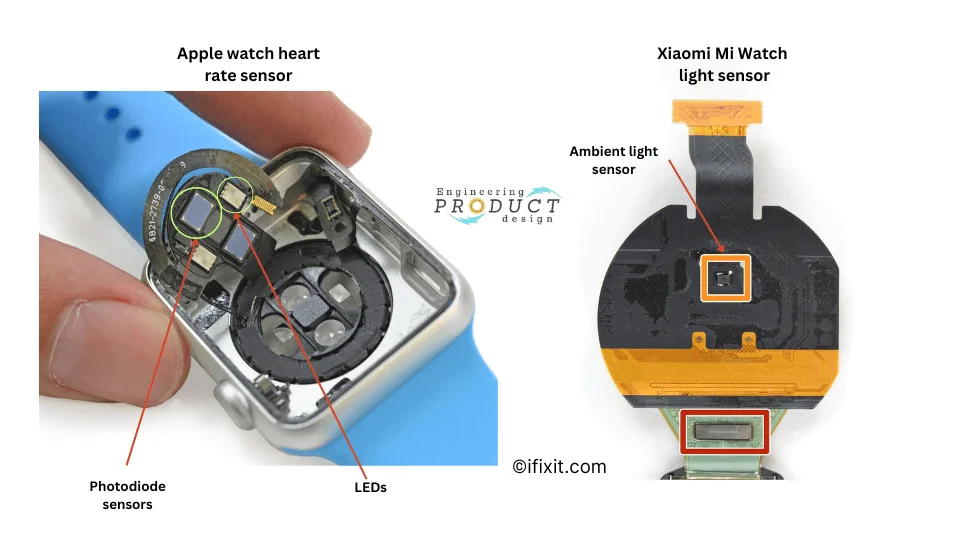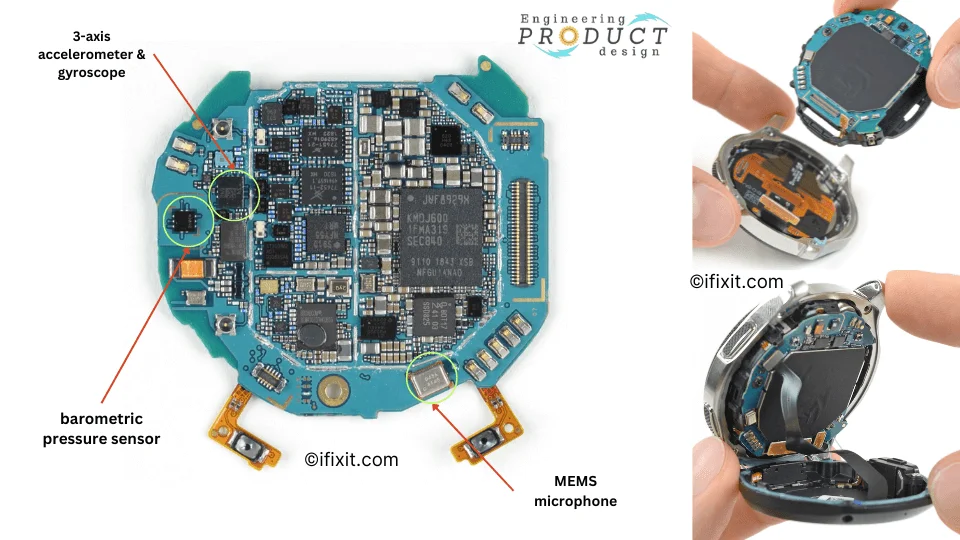Sensors in smartwatches make smartwatches smart by collecting and analysing data from the user. Wearable technology refers to a group of devices—e.g., smartwatches, earbuds and fitness bands —that you can wear throughout the day.
Contents covered in this article

Modern sensor technology allows the constant measurement of people’s health wherever they are using various mobile applications called “apps”. Wearables incorporate these sensors to provide valuable data for modernized, data-driven healthcare.
Heart Rate Monitor
A heart rate sensor in a smartwatch measures the heartbeat of the person wearing it. It typically works by shining light onto the skin and using photodiodes to detect the amount of reflected light. Smart algorithms then uses changes in light reflection caused by blood flow through the capillaries in the wrist to calculate the heart rate. This information can be used for various purposes, such as monitoring exercise intensity, tracking sleep patterns, and detecting signs of stress. Heart rate sensors in smartwatches are generally less accurate than medical-grade heart rate monitors. Still, they can provide a reasonable estimate of a person’s heart rate for everyday use.

This article explains “How Apple Watch measures your heart rate”.
Oximetry Sensor
Oximetry Sensor helps measure the blood’s oxygen saturation. The blood’s oxygen saturation can determine whether the lungs are functioning correctly. The sensor usually shines a light through the user’s skin and measures the amount of light absorbed by the blood. It then uses this data to determine the oxygen saturation level.
Heart rate sensor system with LEDs and photodiodes work together to measure heart pulse rate and the blood’s oxygen saturation.
Ambient light sensor
Ambient light sensors are commonly found in smartwatches to automatically adjust the display’s brightness based on the surrounding lighting conditions. These sensors work by detecting the amount of light in the environment and adjusting the display’s brightness accordingly.
Ambient light sensors can conserve battery life by automatically lowering the display brightness in low-light conditions, helping to extend the overall battery life of the device.
Accelerometer
This MEMS accelerometer sensor helps track your body’s motions by calculating daily steps. Besides monitoring sleep patterns, an accelerometer can help recommend techniques to improve sleep quality. The sensor detects your skin resistance to a specified current that the wearable transmits over the skin to monitor parameters like heartbeat and sleeping patterns.
Gyroscope
It’s a sensor that calculates the body’s orientation and angular rates. Your device’s gyroscope will notify you immediately when you move your wrist to look at your smartwatch. The sensor also helps your wearable save battery life by turning off its display when there hasn’t been any movement.
Barometric Pressure Sensor
The sensor measures atmospheric pressure. It converts this data into an electrical signal. It sends it to the device’s processor, which applies it to determine the atmospheric pressure. The watch’s screen then displays the atmospheric pressure. The GPS sensor is helpful if you’re always on the move (e.g., cycling or running) and need to know your exact location. You can’t get lost in an unfamiliar place with a GPS.

Microphone
A microphone is a device that detects sound and converts it to electrical signals. When your phone is in your pocket, you can use these sensors to make calls directly from your arm. If you have an active Wi-Fi connection, this feature also allows you to make voice calls.
Ambient Temperature Sensor
An ambient temperature sensor in a smartwatch helps to measure the temperature of the environment around the watch, not the body temperature of the person wearing it. This information can provide a general idea of the surrounding area’s temperature but is not a reliable or accurate way to measure a person’s body temperature.
Magnetometer
A magnetometer in a smartwatch is a type of sensor that measures the direction and strength of a magnetic field. This magnetic field data can be used for various purposes, such as determining the user’s orientation and detecting changes in the magnetic field, which can be used for navigation, fitness tracking, and other applications. The magnetometer can also be used with other sensors, such as accelerometers and gyroscopes, to provide more accurate and comprehensive data.
Skin Conductance Sensor
A skin conductance sensor in a smartwatch measures the skin’s electrical conductivity. This information can detect changes in the level of sweat on the skin, which is an indirect measure of stress and arousal levels. Skin conductance is influenced by the activity of the sweat glands, which are controlled by the sympathetic nervous system, and it changes in response to stress, excitement, and other emotional states. Smartwatches can provide insights into a person’s stress levels, sleep quality, and other aspects of their health and wellness by measuring skin conductance. However, it’s important to note that the accuracy of these measurements may vary, and the data should be used as an estimate rather than a precise measurement.
Skin Temperature Sensor
Such a sensor in your fitness band helps tell when there’s an increase in your body temperature and which activity causes it. It enables you to understand how and when over-exercising might increase your body temperature and if you should stop your workout.
GPS
A GPS (Global Positioning System) in a smartwatch or fitness tracker allows the device to determine its location and track movement. With GPS, the device can track the user’s location, speed, and distance travelled, making it useful for fitness tracking, navigation, and other location-based applications. GPS works by receiving signals from satellites orbiting the Earth, which can then be used to calculate the device’s location on the planet accurately. This allows users to track their progress and monitor their activity levels, even when away from their phones or other connected devices.
